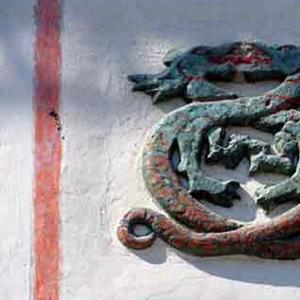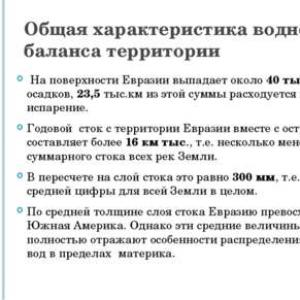Krivandino - Ryazanovka timetable of electric trains (suburban trains). Railway line krivandino - ryazanovka
On the outskirts of the Moscow region there is a remarkable low-functioning railway. Why remarkable? Even after the main purpose of the road - transportation of peat - has become a thing of the past, a passenger train, consisting of a shunting locomotive ChMEZ and one reserved seat carriage, continues to run daily along the single-track non-electrified line.
Length of the railway line Krivandino - Ryazanovka is 53 kilometers. The railway line runs through the Shatursky and Yegoryevsky districts of the Moscow region.
The Krivandino - Ryazanovka line was put into permanent operation in 1944. The railway was built in the shortest possible time - in a few months. During construction, the labor of prisoners of war was used; their cemeteries are located near the railway line.
In the first few years of operation of the Krivandino - Ryazanovka railway line, its length was about 5 km longer - there was a section from the current Ryazanovka station to the village of Radovitsy. On the southern outskirts of Radovits, according to the initial project, the construction of a central settlement of a large peat enterprise was supposed. The construction of the village began, but then it was decided to move it 5 kilometers to the north. A central settlement was built on this place, now known as Ryazanovka (the official name is Ryazanovsky).
The main cargo on the Krivandino - Ryazanovka railway line from the moment of its opening until 2009 was peat. In the 1990s, the Krivandino - Ryazanovka line was named one of the few low-activity sections of the Moscow railway that operate profitably. The volume of peat transportation has always been large. Every day the line passed several freight trains loaded with peat. Freight trains (like passenger ones) were driven exclusively by CHME3 diesel locomotives.
Since the early 1990s, passenger traffic on the Krivandino - Ryazanovka line has increased sharply due to the fact that a gigantic array of garden plots has appeared in the vicinity of Ryazanovka station. The territory of the peat massif between the villages of Radovitsy and Alferovo was allocated for the placement of garden plots (peat mining on it stopped in the 1980s). The number of garden plots soon reached several thousand. The Krivandino - Ryazanovka train, which at that time consisted of three carriages, was often overcrowded during the summer season.
In 2008, due to the refusal of the Shaturskaya GRES (the main consumer of peat) from using peat fuel, the transportation of peat was stopped. The volume of "summer cottage" passenger traffic also decreased, due to the fact that many summer residents moved to cars. The existing minimum volume of freight traffic is insufficient to recoup a significant part of the cost of maintaining the 53-kilometer line. Passenger traffic is a likely candidate for cancellation. Now the "miracle train" consists of one car, the number of passengers is minimal - on the Sazonovo - Ryazanovka section, the car is often empty. To see this "miracle train", to walk through the picturesque places of the Meshcherskaya lowland, where the railway runs - this became our goal last weekend. Our path lay from Sazonovo station to 47 km square.
We got to the Sazonovo station by car. In the village of Serednikovo, near the Church of St. Nicholas the Wonderworker, we turn off the asphalt road to the right (if you are driving from Moscow). Further ahead of us is an unpaved road, but it is quite passable even for a city car, but keep in mind: if the clearance of your car is no more than 15 cm, then you will inevitably cling to the grass with the bottom. We go to the railway tracks, but do not turn to the crossing, but take it to the left, at the next fork we turn right (despite the fact that the road seems to be more rolled straight ahead - this is a dead end that will lead you to the sawmill barrier)
Upon reaching the station, we saw two parked cars with license plates near Moscow: who they are - "geocaches" or hunters (there are many hunting grounds in Shatursky and Yegoryevsky districts) - it is not known, but rather new cars did not fit into the flavor of the half-abandoned village, so it was unlikely that they were local residents. We left our car nearby and set off for the railroad tracks.





On the tracks of Sazonovo station there are quite a few old, rotten through and through wagons and platforms. All valuable things have already been removed from them, some platforms are still linked by "brake sleeves", and some are already "on their own" on rusty rails overgrown with grass.

Traffic lights no longer have a signal value, the arrow on the branch to Pilevo has been dismantled. The Sazonovo-Pilevo line, 33 km long, has been operating since 1976. This railway line was built mainly for the export of peat mined by the Meshchersky peat enterprise (located in the village of Bolon, near the Pilevo station), as well as for servicing the woodworking plant and other enterprises in the village of Radovitsky Mokh.

During the construction of the Sazonovo - Pilevo line, it was assumed that there would be passenger traffic on it. However, the plans did not materialize, there was never a regular passenger traffic on the line. The railway line Sazonovo - Pilevo operated until autumn 2008.
Now the railway line Sazonovo - Pilevo is mothballed. The rails still lie along their entire length, but the turnouts at the Sazonovo station have been dismantled, the path is overgrown with grass.

Our way along a more "lively line" - towards the Ryazanovka station. The railway runs along the embankment among the swampy areas of the forest, so at first we were simply "stuck" by mosquitoes and botflies, and then ... Then we got used to not paying attention to them and moved on.





Despite the fact that trains continue to move along this branch line, the track is in a deplorable state. The concrete sleepers are broken in places, and the wooden ones are rotten. Apparently, there have been no track workers on this branch for a long time: the bolts connecting the sleepers and rails have not been tightened for a long time, the rails vibrate not weakly when the train moves.
After a couple of kilometers, the road goes uphill, the surrounding nature changes: instead of swamps, we see a "dry" forest with a predominance of birches.
From the Sazonovo station we walked about 5 km and saw the next platform on the way to Ryazanovka - 47 km. The fact that there is a platform here is indicated only by a rather fresh sign "Stop of the first carriage"; this place is no different from the rest of the track. Nevertheless, the "miracle train" makes a stop here.

Why stop in a deep forest? Probably, there was once a settlement here: the old lamppost, "hidden" in the branches of an oak, also testifies to this. Seeing a barely noticeable path, we moved along it, and soon came across the remains of a fence with a gate! On the gate is written in large letters: "Beware, angry dog." And then we saw an abandoned village house. Some utensils remained in the house in one of the rooms, in the second - the ceiling collapsed. Nearby, we found several more similar houses - an abandoned settlement, due to its remoteness from settlements, preserved in the form in which it was abandoned. Furniture, clothes were left in the houses, even a TV was found in one of the houses! But even if the object is hidden from looters, then time takes its toll: roofs break in houses and wooden floors fall through.








On the outskirts of the "settlement" we found cellars for potatoes, made in the "classic Soviet style".
The buildings are surrounded by waist-deep nettles, but you should not be afraid of nettles: you should beware of the snakes that live here.



This settlement is not marked on the maps, only on some maps there is a road that crosses this branch line twice. The first is just above (to the north) of the village of Sazonovo station, the second is just in the area of \u200b\u200bthe 47 km platform and the abandoned village. This road is on some maps, but in reality, near the platform of 47 km, instead of a road, you will see only a narrow, barely noticeable path, so you should not try to drive along it even in an SUV!
Do not try to travel to this place without a bicycle: cycling along the sleepers will hardly seem pleasant to you, there are no paths near the railway line.
After inspecting the settlement, we headed back. We had only slightly moved 47 km away from the platform when a diesel locomotive heading for Ryazanovka was noticed in the distance! Here it is - the "miracle train"! One carriage was attached to the locomotive, the passengers in it were not seen.

When we approached the station Sazonovo, we again saw the "miracle train": now it was traveling from Ryazanovka in the direction of Krivandino, made a stop at Sazonovo, stood there for about a minute and moved on.
After watching the train, we moved to our car: then we had the road home ...
The following materials were used as a historical reference:
Original taken from kirillfedorov4 to Railway line Krivandino - Ryazanovka
East of the Moscow region - Meschera - the land of forests and swamps, rich in peat. Not so long ago, peat mining was carried out here, an extensive network of railways operated. To date, only one inactive line has survived. Passenger trains run along it, but if it were not for its location in the prosperous Moscow region, the Krivandino - Ryazanovka line would probably also have been closed. 
The decision to build a line between the Krivandino station on the Moscow-Kazan highway and the Radovitsky Mokh peat massif was made at the height of World War II - in 1943. The construction was unplanned and proceeded in an emergency. The importance and urgency is indicated by the fact that for the construction of this line, rails from another railway (Verbilki - Dubna) were used, which was restored after the war. The construction of the line to the Sazonovo station was completed in an incredible time - less than a year. The Sazonovo - Ryazanovo section was put into operation after the war (but it is possible that the construction was completed simultaneously with the Krivandino - Sazonovo section). In the village of Ryazanovka (on the maps - Ryazanovsky), after the war, a large peat enterprise and the main station of a large narrow-gauge railway arose, overloading from a narrow gauge to a wide one worked.
In the 1960s, the line acquired a side branch to the village of Radovitsky Mokh, which was later extended to the village of Pilevo. Peat-carrying narrow-gauge railway, part of the famous Meshcherskaya main line, also operated in Pilyov.
The main and practically the only cargo until 2008 was peat supplied to the Shaturskaya GRES. Traffic volumes were colossal and the line was profitable even in the 1990s (although intermediate stations gradually began to close since 1995). But in 2008 the power plant abandoned "local" fuel and switched to gas. Perhaps, this step was economically justified, but it is a fact: the inhabitants of many villages of the Shatursky and Yegoryevsky regions were unemployed. Two large networks of peat-carrying narrow-gauge railways were destroyed. The Krivandino - Ryazanovka branch exists only because the Moscow region has decided not to give up passenger traffic and is compensating for huge losses. Cancellation of the train will mean the conservation and subsequent destruction of the line. There is not a single intermediate station left on it (all are closed), the line is a continuous 53-kilometer stretch, on which it is impossible to pass oncoming trains.
We made a trip on the Krivandino - Ryazanovka line on August 24, 2014. We reach Krivandino by train from Lyubertsy-1 station.
After Shatura, a third, abandoned one appears along two main routes. When many trains with peat arrived at Shaturskaya GRES every day, a special track was built between the Krivandino station and the power station so as not to overload a short section of congested main lines. It's amazing that he is still intact. The photo shows the Botino platform. 
At first, the path stretches to the left, then crosses the main passage along the overpass, after which it turns out to be on the right. 
There is no train station at the Krivandino station; tickets are purchased at the box office on the platform. 
Not everyone knows that the former Krivandino railway station has survived nearby, and it was built before the revolution, however, now it is used as a residential building. (Photo taken in March 2013).
And here's what he looked like a hundred years ago:
At a low platform, away from the main tracks, a "rail bus" was already waiting for us - a lonely carriage RA1. Until May 2012, trains consisting of a diesel locomotive ChME3 and one reserved seat carriage ran here, giving this road a unique flavor. Such trains are popularly called "cuckoo" and "foundling". However, PA1 has already managed to become the same attribute of deaf and inactive railway lines. 
There were very few passengers in the carriage, about six people, despite the summer season and Sunday.I was very surprised by the absence in the carriage of ... the cashier! We bought a ticket to Ryazanovka at the box office on the platform, but there are no ticket offices at the stops along the line, that is, the train is actually free. It is possible that on that day we were the only ones who "sponsored" the Ryazanovskaya branch.
Departure at 14:40. On the left are the main roads. 
And warehouses. 
The "civilized area" is gradually ending. 
And the delightful meschera landscapes begin. 

In late summer 2014, track repairs were carried out on the Krivandino-Ryazanovka line. The fresh rails had not yet been rolled, so in places an unusual sound called "singing rails" could be heard. It is characteristic precisely for lightly loaded branches and only in the first months after the repair, that is, the phenomenon is quite rare. Some, hearing this "singing" for the first time, perceive it for broadcasting Wagner's music :-)
Particularly beautiful views open up on the curves, of which there are a lot here due to the hilly terrain. 

Osanovo village next to the station of the same name, which was closed in 2004. 
The station building, alas, has not survived, but concrete sleepers can be found in the grass. 
Meschera is one of those lands to which you want to return again and again ... 
Notch: 
Soon the village of Pozhoga is shown. 
The wooden house of the station attendant has survived here, although the station was closed first on the line, in 1995. Before closing, there was a terminus for one of the passenger routes. The sleepers of the second track are also noticeable. 
After the Burns, swamps begin. As you can see in the photo, the forests along the road were badly damaged during the 2010 fires. 
Sanitary deforestation along the road is underway. 
Forest stopping point 29 km. 
At Barmino station, the second track is still preserved (although it is cut off from the main one, there are no switches). It was closed in 2009. In the vicinity, in addition to the station settlement of Barmino, there are large villages of Terekhovo, Serednikovo and Samoilikha. 
The boarded up station building with the door ajar looks very ominous. 
Traces of the past improvement: 
One can imagine what drivers think about a carriage carrying less than a dozen people. 
From time to time rowan bushes come across along the line. 
The technique left for the weekend in the forest, apparently, clearing space along the paths. 
Scenic drive near the village of Sazonovo. 
By the standards of the Moscow region, this place is a rare wilderness. The permanent population is less than 10 people. Here is the last and at the same time, oddly enough, the largest intermediate station on our way, which operated the longest. Also rusty rails cut off from the main track. 
Water tower. Most likely, it has nothing to do with the railway. 
And the boarded-up station building is exactly the same as we saw at Barmino station. 
Passenger platform for half a car. 
Once upon a time, there was a busy cargo work. 
To the left, there are traces of a disassembled side branch - the Sazonovo-Pilevo railway line. The line has not been operating since 2009, and gradually the rails were plundered by local residents, as is now happening with the Valdai-Kresttsy line in the Novgorod region. In 2012, the rails still remained in the area of \u200b\u200bthe village of Prudy and between the stations of Sorokovaya Bor and Pilevo. In August 2014, they were no longer left anywhere. I am planning to write a separate photo report about this line. 
There is only half an hour left to go to Ryazanovka. The last section looks the most deaf. 
This is what a 47 kilometer stopping point looks like, located at a distance from settlements. There is not even a platform. The location is determined by the timetable plate. Actually, passengers here are a very rare occurrence, the train does not always stop. 
You can hardly make out a small abandoned hut. 
And finally, after almost two hours of travel, the train arrives at the already familiar Ryazanovka. Station tracks: 
The station looks very well maintained. 
A rare phenomenon now - the paths are busy with trains. True, not by carriages with peat, but by repair equipment. 
The locomotive driver once again reminded me that "it is forbidden to rent the railway", although, of course, I did not break any laws.
We already visited Ryazanovka in 2013, although the goal then was to visit the Nikolo-Radovitsky Monastery. I managed to take photos of the move. Directly earlier, the road went to peat transshipment, now - only to the boiler house and the local refrigeration plant. The movement is very rare. 
And here is what remains of the huge network of narrow-gauge railways. Rails at the crossing south of Ryazanovka. By the way, double-track sections are a very rare occurrence for narrow-gauge railways. 
Thanks for attention. I would like to hope that the Krivandino - Ryazanovka line will work and attract travelers with its wonderful landscapes, and will not repeat the fate of the Sazonovo - Pilevo line.
The current schedule of electric trains Krivandino - Ryazanovka includes 3 electric trains (suburban trains, diesel engines), which connect these stations, among which there are morning, afternoon, evening. The fastest electric train (suburban train) is recommended, which departs at 21:05 from the Krivandino station and arrives at the Ryazanovka station at 2253 hours. Ryazanovka, in this case the trip will take 1 hour 48 m. Between the stations of Krivandino and Ryazanovka, this electric train passes 7 stops. Among them are Osanovo (21.25), Pozhoga (21.41), Barmino (22.15), 47 Km Stopping Point (22.38), where it is possible to change trains to electric trains of other directions. On this page you can always find out the timetable of the Krivandino - Ryazanovka electric trains, including the seasonal one, which is valid in summer and winter. Before planning a trip on the Krivandino Ryazanovka route, first read the schedule on our website, and also check this schedule at the nearest train station, as some operational changes are possible.
Tickets for the Krivandino - Ryazanovka train can be purchased at the box office of the nearest station.
About the train on the Zemtsy - Zharkovsky line, which is usually called the slowest train in Russia. But in the Moscow region there is also its analogue. Only he walks more often: not twice a week, but three times a day. But he is also very leisurely.
So, we arrive in Krivandino. The train goes further, to Cherusti:
Old station building built in 1912:

And next to it is the house of the station attendant of the late 30s. The same, for example, is at the BMO in Nerskaya:

On the next track there is a shunting track with the composition:

And behind it hid the second, low platform of the station, where almost everyone who left the train in Krivandino turned. "All" is about five people. And I am one of them. The rail bus RA1-0019 was waiting for us at the platform:

Don't ask me what the person on the right side of the frame is doing :) By the way, I have never traveled to RA1 before. The salon is the same as that of the friends of RA2:

The seats are wider than in a commuter train, and the windows are wider. But you won't be able to sleep very much on them, as in a reserved seat carriage, which ran here fifteen years ago. And the sensations are completely different: a diesel engine rattled under the floor, luggage racks rattled, a beep - and we drove off:

At first, outside the windows stretched the suburbs of Krivandino, warehouses and summer cottages. And then a dense pine forest began:

Occasionally cut by rivulets:

The speed of the train is no more than thirty kilometers per hour. Sometimes it falls even lower. Of course, you have to shoot through glass - but the windows are clean enough. There are six - seven passengers in the carriage, no more. Houses of summer cottages run out of the forest:

Although behind the trees and two-story buildings you can see:

This is the first stop - Osanovo. Here not only half of the passengers get off, but two also sit down. It seems that all the passengers on this train know each other - they greet each other, ask how are you doing:

Previously, the forest approached directly to the tracks, but then, according to the well-known order of the Russian Railways, it was cut down along the line for fifteen meters. Therefore, from the car it became possible to see the curves into which our car is slowly screwed:

The next stop is Pozhoga. The station village is small:

But the station building has survived here, possibly from the time of the construction of this line - 1944:

Below I will add another photo of him. And on the outskirts of the village there is a snow-covered football and volleyball field, in the middle of which stands unknown, like a Volga that drove into these snowdrifts:



But it's beautiful:

Loves such places ed4mk_0024 ;)

We brake near the platform for 29 kilometers. A man leaves the carriage:

And it leaves along a barely noticeable path straight into a dense forest:

Well, that's the truth! Straight to the forest! Where did he go?

Then I looked at the map - there, half a kilometer away, was the village of Maleikha. As in the taiga ... But this is the Moscow region. It would seem that it is less than one hundred and fifty kilometers from Moscow - and Megafon does not catch at all, and MTS only shows two "sticks".

In the carriage, except for me, there was one passenger. Initially, I did not plan to go to the final one - there is a parking lot for only ten minutes, so what time can you make it? Take a couple of shots, yes, sorry, recover :) Therefore, I planned to get to Sazonovo - the former junction station, from where the line to Radovitsky - Pilevo departed. But, then, he reasoned that under the snow you still won't see much, and decided to get out, like fifteen years ago, at the Barmino station. There is at least some kind of civilization nearby. And so, I climbed down onto the narrow platform, and PA1 rolled on:

Very slowly:

To quote myself ten years ago: Barmino Station is something fantastic. Rails hidden by snow, a platform made of a pair of reinforced concrete slabs laid on an embankment, a small panel house for the dispatcher with a dim light streaming from one of the windows through blackout curtains - and an endless snow-covered field around ... A few hundred meters from the station - ruined and abandoned a brick factory, behind it begins a dense forest, almost black in the coming twilight ... Nothing changed:

Only, perhaps, the officers on duty who were sitting there fifteen years ago have disappeared from the chipboard house:

View towards Krivandino:

I had a little over an hour to walk to the village of Serednikovo located near the station. I took a walk, but I was almost late back to the train. But, nevertheless, he had time. There was only one passenger in the cabin from Ryazanovka, no one sat down with me either:


Again the unhurried movement of the car, the measured rumbling of a diesel engine, occasionally gaining momentum, the loud clatter of wheels at the joints, and the rattling of luggage racks. And - the dense forest of the Meshchera region outside the windows:

For me personally, this line is firmly associated with another railway, which also passed through the forests of Meshchera - the narrow-gauge line Tumskaya - Ryazan. The very one that Paustovsky and Yesenin wrote about once. But that line was very close to the line to Ryazanovka - only some thirty kilometers away, and they even had a connection through the Sazonovo - Pilevo branch. But alas, all this remained in the distant past. At the stops, passengers got into the carriage one by two. Here is the former Pozhoga station again.







